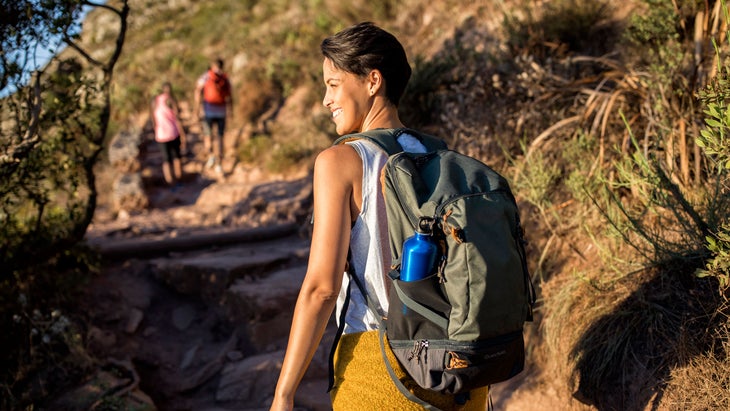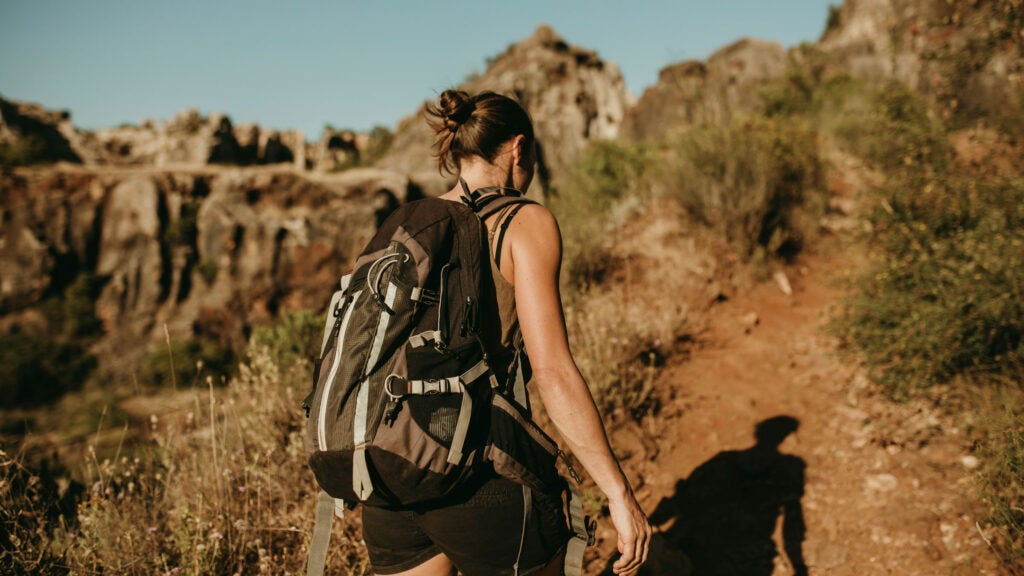No products in the cart.
Outdoor Adventure
What I Learned from 30 Days of Rucking
While backpacking in the Adirondacks last year, I listened to The Comfort Crisis by Michael Easter. As I scrambled up the trail’s slick rocks, trying my hardest not to fall before reaching the summit of Nippletop, Easter warned me about a different danger: the eradication of discomfort. Sure, the amenities of modern life, such as cars, on-demand food, and temperature-controlled environments, ease our daily lives, but he argued they also erode satisfaction and fulfillment by depriving us of fundamental human skills and experiences.
So, what’s the antidote to this problem? Well, engaging in strenuous exercise helps, as does facing challenges in harsh natural environments. Easter also advocates for rucking, or walking with a weighted pack for exercise, to get in touch with a fundamental skill of our hunter-gatherer ancestors.
I was skeptical. Rucking seemed like just another trendy fitness craze, but with origins in the military, where marching for long distances with a loaded pack, is a fundamental training activity. Besides, personal trainers frequently recommend using weighted packs to train for a long trek. What sets rucking apart?
Suddenly, Rucking Is Everywhere
After that weekend in the wilderness, several rucking-related TikToks caught my attention. My feed was full of explainers, couples going on rucking dates, and fitness influencers documenting their 20-mile rucks.
When GORUCK, a company that makes backpacks explicitly designed for rucking, offered me a chance to try its signature product, my curiosity was at a peak. I embarked on a 30-day challenge to explore what the buzz was about.
The Benefits of Rucking
There’s no denying rucking is an efficient workout. The added weight on your back strengthens your legs and trunk, while simultaneously giving you a low-impact cardio session. These benefits increase when you add hills to the mix. Heading uphill with a pack pushes your VO2 max, while going downhill challenges your stability and eccentric muscle control, according to longevity expert Peter Attita.

What You Need to Know About Rucking
During my month-long experiment, I rucked with GORUCK’s 20-liter Rucker 4.0 and 20-pound Ruck Plate (sometimes with 5 to 10 pounds of books added for extra weight), my Gregory Jade 28 Backpack with two 10-pound barbell plates, and, of course, my 30-pound toddler in a Deuter Kid Comfort Child Carrier. These are my key takeaways.
1. Don’t Overanalyze It
At first, it was difficult for me to set parameters for the challenge. My inner perfectionist wanted to do every rucking session over uneven terrain. Simply walking on the paved streets in my neighborhood didn’t seem like it should count. But Easter assured me that rucking on my local sidewalks was more than sufficient.
The duration was another concern. Was 30 minutes really enough to experience the cardio and strength benefits? Or should I aim for at least an hour? During the first week, I didn’t hit either of those time stamps. My writing assignments, strength training routine, and daycare pick-ups took priority, leaving me with just 15 minutes a day to ruck. (On one unfortunate day, an unexpected thunderstorm also deterred my plan.) I eventually found balance, examining both the weather and my personal to-do list to find the best time for my daily trek. By the end of the month, my sessions ranged from 15 to 90 minutes long, averaging around 45 minutes.
2. Using a Fitness Tracker Is Complicated
As an Apple Watch addict, the prospect of logging these workouts excited me—until I found out that there isn’t a “rucking” setting. To work around this, I decided to label my neighborhood rucks as “outdoor walks” and rucks on uneven terrain as “hiking.”
But I wasn’t getting full credit for the assignment. The device couldn’t account for the extra 20 to 40 pounds I was carrying. And while I was exerting more energy than a typical hike, due to the added weight, my watch interpreted my higher heart rate as a decrease in my overall cardiovascular fitness. To avoid this, I started manually excluding my rucking sessions from my Apple Watch’s VO2 max data.
3. It’s a Nice Way to Do Zone 2 Cardio
During the 30-day challenge, I observed how different factors affected my heart rate during rucking. For example, carrying my daughter up steep inclines spiked my heart rate between Zones 3 and 5, according to my Apple Watch. My pack appeared to have the opposite effect on flat sidewalks, where I couldn’t move quickly enough to get my heart rate above Zone 1.
However, using the Rucker 4.0 with 20 pounds of weight over rolling hills transformed a typically mundane walk into a beneficial Zone 2 cardio session. In Zone 2, you train at an easy-to-moderate intensity where conversation is still possible, corresponding to around 60 to 70 percent of your maximum heart rate. Many adventurous, high-intensity athletes spend their time pushing into Zone 3 or recovering in Zone 1. It’s often difficult to find the sweet spot of Zone 2—and even more challenging to do without using a treadmill or stationary bike (which I personally find joyless). Rucking with a light pack proved to be the perfect solution.
4. It’s a Great Workout for Parents of Young Kids
If you’re a parent who wants to exercise, you’ve likely been told to just plop your child in a stroller and go for a walk. But that may not be challenging enough for you. You also may not want to splurge on an expensive hiking carrier or jogging stroller. (I get it.) Rucking strikes the perfect balance of intensity and manageability. On days without childcare, I put my daughter in the stroller and donned the Rucker 4.0 on my back instead of struggling with my hiking carrier.
5. A Dedicated Rucker Is Nice (But by No Means Required)
The Rucker 4.0 became my go-to choice for my daily sessions. Its nondescript black color and inconspicuous shape made it versatile for various outings, unlike my noticeable Gregory Backpack with a hip belt that often felt awkward. The Rucker’s comfortable straps and even weight distribution impressed me.
However, spending more than $300 (the price of the Rucker 4.0 is $245, and the 20-pound plate is $105) on specialized gear isn’t necessary. As you get started, try rucking with items you already have, such as exercise gear, water bottles, or even bags of rice on your next walk. However, keep in mind that this may lead to uneven weight distribution, as these items tend to collect at the bottom of the pack, which can be irritating from time to time. (You can always invest in the dedicated equipment later on.)
6. It’s a Lower Impact Alternative (or Complement) to Running
In addition to rucking, I maintained my regular exercise routine, which consists of functional strength training two to three times a week and HIIT once a week, all month long. However, my (already) infrequent runs fell by the wayside. There was a silver lining to this change: my occasional, mild hip pain disappeared.
While I’m not ready to throw in the towel on jogs, rucking provides a much-needed middle ground between a leisure walk and a strenuous run. It’s more effective at building my cardiovascular endurance than walking—and easier on my joints than running.
7. Rucking Is Surprisingly Fun
I’ll admit it: I had fun rucking. While treking around, I could catch up on podcasts or audiobooks, and it barely felt like exercise. Walking in the woods while wearing a backpack reminded me of the hours I spent playing in such environments as a kid.
In the future, I plan to integrate one to two hours of rucking into my week, whether to do some Zone 2 training or enjoy my local nature trails. I may just be a rucking convert—even though I’m relieved to no longer carry the daily burden (both physical and mental) of my 30-day challenge.
Source link

